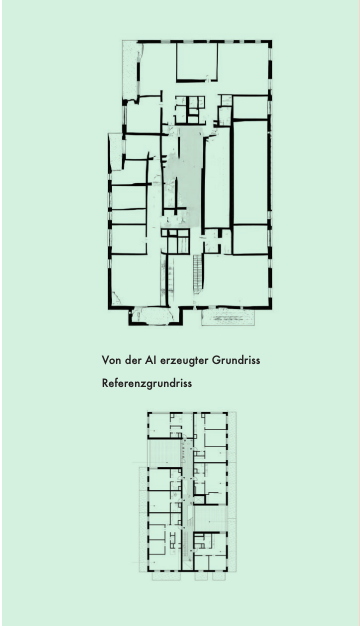Artificial Intelligence and Architecture: Taking the Vienna Gemeindebau to the Next Level
With the project “Big Data und das Gebaute Erbe Wiens” (Big Data and Vienna’s Built Heritage), artist and architect Alunovic Oliver presents an artificial intelligence that independently designs architectural projects. The project uses the city of Vienna’s open data on all realised projects of the so-called Wiener Gemeindebau (Viennese communal housing), on which the neural networks used are trained. The aim is to make the Wiener Gemeindebau sustainable as a digital content creation tool, to pass on the cultural heritage of the Wiener Gemeindebau and to offer architects a tool for creating high-quality communal housing.
Oliver, you are working at the interface of architecture and digital art. What fascinates you about the field you work in?
Hi, Forward Magazine, thanks for the question and thanks for having me here. In my work I am generally really interested in social agendas, the public sphere, collective identities, the anthropocene, cultural heritages and generation conflicts. Also in my studies I was heavily influenced by literature of Hannah Arendt and Bruno Latour.
And the first time I was really working with digital methods was in 2018, when I was working on a research project regarding informal settlements in Europe. This was the first time when I was using Big Data and Data Mining Tools, for getting a better understanding of certain communities that I am not a part of. After this project I started to combine my traditional education and practices in art and architecture with digital tools and working methods. This was the first time when I felt that there was a certain momentum and interest regarding my own work.
And to be honest, since then I have been surprised and grateful every day by the projects and people I have been able to work with. For example, I just finished a competition for art in public spaces with the sculptor Hans Schabus. We had to design a 150-meter intervention for the Hofburg in Vienna that serves as a protective barrier against terrorist attacks, and I’m currently developing a series of sculptures for the Museumsquartier with artist Judith Fegerl that are about solar panels and how to optimize them using public climate data. I really believe that my approach of combining programming with traditional working methods of art and architecture allows me to find specific solutions to contemporary problems. And a transdisciplinary team with fruitful discussions allows projects to really grow and evolve into something I find meaningful.

What was your motivation or idea for choosing the Vienna Gemeindebau for this project? Is there anything that particularly inspired you?
For a long long while I was thinking about using the projects of the municipal housing of Vienna for the creation of an AI and I really wanted to know if it would be possible to use the data of the city for something meaningful.
At the time I had been living in Vienna for ten years, I witnessed different masterplans of the urban development of the city, and the MUSA had an exhibition celebrating the history of Viennas communal housing program. The architecture magazine Arch+ was planning to publish a volume on the City of Vienna.
As chance meets opportunity Michael Obrist, who was in charge of this certain volume of the Arch+ magazine really liked the idea. I saw the published work as a proof of concept. Since then GANs(generative adversarial network) got stronger and faster. It is really surprising and generally I think now is the best time for such a project.
To what extent is AI technology helping you make this project happen?
I don’t consider AI as something surprisingly new. Machine Learning and Neural Networks allow the development of new tools that allow us to engage in intuitive and surprisingly different workflows. AI allows us to incorporate a completely different approach on interacting with a certain UI.
And a side note :
Actually Big Data tools are already embedded in so many levels of our daily life, we don’t event recognize them anymore. It is really funny, creating a Machine Learning Model means a lot of scripting in python and today even AI extensions for python exist that help you in writing your code for the creation of an AI.
Do you think other architects are open to work with AI? Do you see a trend? How do you think this will develop in the future?
I definitely see a trend in AI methods being applied in the creative industry. I cannot even list how many programs are already using AI as part of their functionality. AI, Machine Learning and Big Data are definitely getting more mainstream, but what really is important is knowing what kind of code you are deploying. Because using the AI has two sides one side is developing the neural network and the other side is using it. This is quite dangerous, because we can never know which data was used for the creation of a specific machine learning model. And this knowledge is key for the creation of a sustainable relationship with our tools.
Where do you see the future of architecture and building design?
In design, I’ve never really been interested in aesthetics, but I always keep in mind that what I design is embedded in a certain cultural context. Architectural design is not for ourselves, but for others. Machine Learning and Big Data can help us get an understanding for how a certain space might be used, or in which cultural context a certain space needs to be embedded in. Also with the climate crisis, every house in the future will serve as a small electrical factory. Digital and automated methods for these aspects in architecture are heavily needed. Only last week I started developing a digital pipeline for this purpose and I am curious where this will go to.
Creative work can be accompanied by a lot of questioning and doubts. Where do you find motivation and inspiration to move forward in difficult times like these?
I always like to consider my work as a certain kind of craft. I define myself as an artist, but really I don’t consider it as a prestige. Working just keeps me healthy and gives me a purpose. Also I learned certain crafts and I always keep developing them. I never know where this leads me to. I am generally not a cynical person and I love to learn and love to apply the things that I learn. This motive followed me most of my life. I see some people having a really narrow view on what is art and what is good or bad. And I see them struggling a lot, because in the end they carry a lot of negative energy with their craft that they are spending most of their time with.
In the end I am just thankful for the places that I could travel to and people that I had the opportunity to work with. A lot of times I am thinking back at my 13 year old me, who started painting just for the sake of it. Even now almost all of the things that I do are really just for the love it.
Where else do you see AI supporting and improving development in other areas?
AI is being applied on so many levels.
I’m bored with talking about human-like androids that you can talk to. These things sell well, and these thought experiments are funny, but what interests me more is, for example, the independent investigation of incurable diseases with Big Data evaluation tools. Independent of any financial interests. My big hope in using AI and Big Data is in science and research, in providing knowledge for medical treatment, in enabling accessible education. Tools that are really made for a purpose. Let’s try to invent things for today and not talk about science fiction narratives and fears from the 70s.
Your portfolio states that you are trying to uncover gender relations in digital spaces and objects with the help of AI and Big Data. Can you explain the process behind this?
Thanks for this question.
For example in 2019 I was reverse engineering the algorithmic model, that our automatic translation tools are using. It is quite difficult to explain in words, but generally for the creation of these tools a big dataset of meaningful text needs to be vectorized. Language is a complicated construct and the benefit of vectors is that it’s possible to perform mathematical calculations with them. A vector indicates a relation in an n-dimensional space. So a Big Chunk of Text can be vectorized and with this mathematical model we get all the relation of the words within the text to all the other words.
All languages are somehow similar, but there are different methods in different languages on how to inscribe a certain gender to a subject. The vectorized model allows to transpose genders from one language to another. And by reverse engineering this mechanism it is possible to uncover certain gender relations in a dataset. It’s not an absolute truth, but it allows the investigation of certain stereotypes regarding gender and language.
Now for architecture: if we can inscribe a gender value to a word, we can inscribe a gender value to any architectural element. And with these values we can easily calculate with and construct spaces that originate from a very different logic than what we as designers are accustomed to.
Also in 2020 and 2021, I used a different machine learning method for creating large photographs of skin that came from a database of different species with a variety of genders, for creating 1 to 2 meter skin fragments that have no gender attributes. It’s really interesting to face a skin with all its pores, hairs and scars that we can’t assign an attribute to. It is a game and a neglect of our instinct to categorize the things we see before our eyes.

If you are interested in the development of creative spaces in Vienna, check out the Vienna Business Agency’s competition Creatives for Vienna – Making Spaces. The Vienna Business Agency is looking for concepts for the creative use of spaces in Vienna, including interim use projects. The winners of the competition will receive prize money of 15,000 euros for their concepts. The call for projects is open from 17 November 2022 to 15 February 2023.